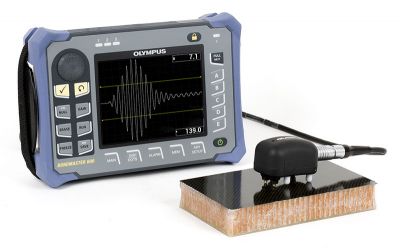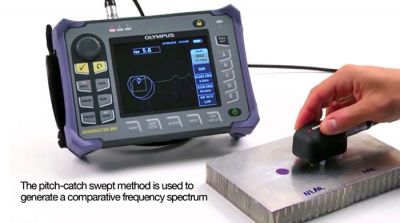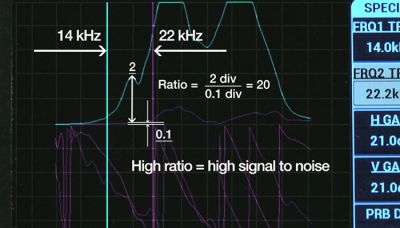Configuring your instrument so that you get the best parameters for bond testing can be challenging. It’s not always easy to find the proper frequency for detecting skin-to-core disbonds.
However, learning to configure your bond testing instrument isn’t magic. There’s a scientific, practical method for obtaining the correct frequency (and other parameters) for testing honeycomb composite. It’s all about frequency and vibration. This concept is essential for understanding how to configure your bond tester to get great results.
 |
| The BondMaster 600 bond tester. |
The BondMaster® 600 portable bond tester includes functions that, when used together, help make it easier to develop bond testing applications or test procedures. These tools help users identify the correct frequencies for testing honeycomb composite.
 |
| The pitch-catch swept method on the BondMaster 600 bond tester. |
This array of functionalities is primarily aimed at NDT specialists that write NDT procedures or guidelines, or laboratory personnel seeking to advance composite testing.
 |
| Achieving a high signal-to-noise ratio is important for any bond testing instrument. |
Why is having the right frequency so important?
Membrane resonance is the dominating principle for detecting skin-to-core disbonds. One way to think about a skin-to-core disbond is as a vibrating membrane, like the skin of a drum. A drummer in a band produces different sound pitches, or frequencies, by playing drums that are different sizes. However, other members of the band, such as the bass player, can also cause the drums to resonate.
Ambient sounds coming from the bass amplifier can cause resonance in one or more drums, depending on their sizes. Some sounds, or frequencies, played by the bass will cause very specific drums to resonate, while other sounds will make the entire drum set resonate.
 |
| Different size drums resonate at different frequencies, just like a skin-to-core disbond. |
If all of the drums are resonating because other musicians are playing, this is obviously annoying to the band as well as the sound engineers! However, this is exactly what a good BondMaster 600 configuration is aiming at. The BondMaster 600 instrument’s functions described here enable inspectors to find one single frequency that will make all skin-to-core disbonds vibrate enough to be detected.
Like the top and bottom of a drum skin, skin-to-core disbonds have a near side and a far side. In a drum, both skins are not always tuned to vibrate at the same frequency. Similarly, the near side and far side of a disbond will not necessarily vibrate strongest at the exact same frequency. However, as discussed above, it is often possible to find one frequency that will cause both the near side and far side skin-to-core disbonds to vibrate enough to be detected.
 |
| A near side skin-to-core disbond. |
 |
| A far side skin-to-core disbond. |
The full method used to configure your BondMaster 600 instrument to get the right frequency for inspecting honeycomb composite is described in this video. The benefits of using this method include:
- Identify the frequency needed to detect disbonds in honeycomb composite
- Reduce the number of frequencies used to obtain a reliable test (one is often enough)
- It’s a repeatable and recordable methodology
- You’ll get a better overall understanding of composite testing
The BondMaster 600 instrument’s functionalities discussed in the video include:
- The pitch-catch swept (frequency sweep) method
- Spectrum view
- Reference signal
- The instrument’s frequency tracking functionality
Following the procedure outlined in the video will help you find the frequency you need to get the job done as efficiently as possible.
Get In Touch
.jpg?rev=2D3E)
